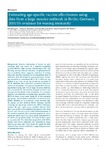Estimating age-specific vaccine effectiveness using data from a large measles outbreak in Berlin, Germany, 2014/15: evidence for waning immunity
Bitzegeio, Julia
Majowicz, Shannon
Matysiak-Klose, Dorothea
Sagebiel, Daniel
Werber, Dirk
Background
Measles elimination is based on 95% coverage with two doses of a measles-containing vaccine (MCV2), high vaccine effectiveness (VE) and life-long vaccine-induced immunity. Longitudinal analysis of antibody titres suggests existence of waning immunity, but the relevance at the population-level is unknown.
Aim
We sought to assess presence of waning immunity by estimating MCV2 VE in different age groups (2–5, 6–15, 16–23, 24–30 and 31–42 years) in Berlin.
Methods
We conducted a systematic literature review on vaccination coverage and applied the screening-method using data from a large measles outbreak (2014/15) in Berlin. Uncertainty in input variables was incorporated by Monte Carlo simulation. In a scenario analysis, we estimated the proportion vaccinated with MCV2 in those 31-42 years using VE of the youngest age group, where natural immunity was deemed negligible.
Results
Of 773 measles cases (median age: 20 years), 40 had received MCV2. Average vaccine coverage per age group varied (32%–88%). Estimated median VE was > 99% (95% credible interval (CrI): 98.6–100) in the three youngest age groups, but lower (90.9%, 95% CrI: 74.1–97.6) in the oldest age group. In the scenario analysis, the estimated proportion vaccinated was 98.8% (95% CrI: 96.5–99.8).
Conclusion
VE for MCV2 was generally high, but lower in those aged 31-42 years old. The estimated proportion with MCV2 should have led to sufficient herd immunity in those aged 31-42 years old. Thus, lower VE cannot be fully explained by natural immunity, suggesting presence of waning immunity.

